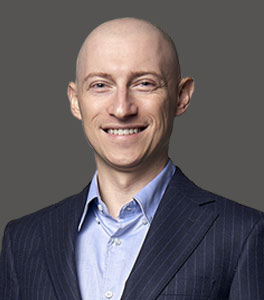

Blepharoplasty, or eyelid surgery, is a treatment that improves the signs of aging around the eyes. During this type of plastic surgery, a top-rated plastic surgeon in New York City Dr. Gary Linkov removes skin, muscle, and sometimes fat that may be causing the area around your eyes to sag. At City Facial Plastics, located in Midtown, Manhattan, we address changes to the upper and lower eyelids with a blepharoplasty, or eyelid surgery.


Eyelid surgery includes a series of procedures that reestablish beautiful eyelid contours and proportions. Eyelid surgery can address the upper eyelid (upper blepharoplasty/ptosis repair) and the lower eyelid (lower blepharoplasty/canthopexy). Each eyelid surgery has its own nuances, approaches, and surgeon preferences. The key is to pick the appropriate approach to compliment a person’s anatomy and clinical situation.
It is equally important to foresee potential complications and avoid them from the beginning. Adjuvant non-surgical treatments such as neuromodulator, filler, chemical peel, and laser resurfacing can compliment eyelid surgery and create a harmonious final outcome.
Beautiful eyes are a fundamental component of the face. They serve an incredibly vital function and are also aesthetically important. As with other facial structures, eye form follows function. By restoring natural eye aesthetics, eye function may also be improved. The most long-lasting eyelid restoration results are achieved with eyelid surgery NYC.
3 months after an upper blepharoplasty eyelid surgery to open up this patient’s beautiful eyes. She also had an upper lip lift at the same time.
4 months after an upper blepharoplasty eyelid surgery was performed to remove excess skin. She is delighted with her results and has an easier time now applying make-up.
This kind and cheerful woman presented with extra upper eyelid skin. Since she had a dry eye condition, we decided to go for a conservative approach in performing her upper eyelid blepharoplasty. You can see improved upper tarsal platform show in the bottom after image.
Excess skin on the upper eyelid is a common issue with aging. The skin becomes thinner, stretches and sags. This can make the eyes look tired and even sad. In some cases, drooping upper lids can be so prominent that it becomes difficult to completely see. In these cases, blepharoplasty surgery may even be able to improve vision. Surgery involves removing or repositioning excess skin and/or fat, as needed.
Under the eye, sagging skin can create bags and wrinkles. This can make you older and tired. A lower eyelid blepharoplasty or eyelid lift plastic surgery removes the excess skin and fat that creates bags under the eyes. This can smooth and tighten the area below the eye for a revitalized and rejuvenated appearance. The incision is usually discreetly placed below the lower lashes.
I cannot say enough about Dr. Linkov and his staff. From the initial consult to day of surgery and post op appointments, I have had nothing but an outstanding experience. During the consult Dr. Linkov went over everything in detail and was honest compassionate throughout. I didn’t feel rushed and he answered all my questions. Leading up to the surgery, Bianca, the receptionist, was amazing. She was very responsive/professional with all my questions, and all the necessary pre-operative preparations that needed to be done. During the surgery Dr. Linkov and his team were wonderful. I felt comfortable and calm during a long surgery. Dr. Linkov followed up afterwards to make sure I was doing well. If I could give more than 5 stars I would! Highly recommend!
Mrunal Parmar
In many cases, our patients want both an upper and lower eyelid lift to completely rejuvenate their eyes. Upper and lower eyelid surgery can help open the eyes and reduce the bags and wrinkling. It is common for a brow lift to be combined with a blepharoplasty surgery to improve the overall upper portion of the face.
The following clinical signs are well suited for eyelid surgery (blepharoplasty):
These characteristics define a beautiful eyelid, such as:
The primary types of eyelid surgery include:
Eyelid surgery is performed under local anesthesia or deep sedation anesthesia depending on patient and surgeon Dr. Gary Linkov preference, the extent of the procedure, and if any combination procedures are planned. During every eyelid procedure, the cornea should be adequately protected with a corneal shield. Sterile technique is always maintained.
The basic surgical steps of the five primary types of eyelid surgery NYC are presented below.
Once you have decided to undergo eyelid surgery, the best-in-class plastic surgeon in Manhattan, NY Dr. Linkov will discuss in detail how to prepare for your procedure at plastic surgery clinic.
There are a few steps you should take before your eyelid surgery to get the best results. These steps include:
If you have any dry eye symptoms it is critical that you report that to your doctor. Most eyelid surgeries can worsen dry eye and a thorough eye exam by an ophthalmologist is necessary before any eyelid surgery.
On the day of your eyelid (blepharoplasty) surgery at City Facial Plastics in UES, Manhattan, if you are getting deep sedation anesthesia, it is important not to eat or drink 6 hours before your scheduled surgery.
If performed under deep sedation with an anesthesiologist, you will be asked to change into a surgical gown and women of child-bearing age will need to take a pregnancy test. The intake process can take about an hour, the surgery usually takes 1-3 hours, and recovery will be about another hour. If performed under local anesthesia, the area is thoroughly numbed before any incision is made and fasting is not necessary.
A special eye antibiotic ointment is provided for either use on the skin incision or in the eye, depending on the exact eyelid surgery performed. It is okay to shower the day after the procedure. When lying down, it may be helpful to elevate the head of the bed for at least one week. Light activity is recommended for the first two weeks.
Localized bruising and swelling are expected for 1-2 weeks, with some degree of swelling lingering for months. If non-dissolvable sutures are placed they are removed on day 5-7 after surgery. An external incision can stay red for weeks to months. It is best to avoid direct sun exposure to the treated area for several months after eyelid surgery.
The risks and complications after eyelid surgery (blepharoplasty) include:
As you can see, many issues can arise from eyelid surgery. It is important to choose the leading plastic surgeon NYC who understands these potential problems and has strategies in place to avoid such eyelid surgery complications.
There are patients who may not be good candidates for elective eyelid surgery, including:
There is no true replacement for eyelid surgery in the correct setting. However, complementary treatments that address the skin, muscle, or volume loss may be beneficial. These include:
Lifelong satisfaction is possible after blepharoplasty NYC. A study in 2017 of 45 patients (90 eyelids) found that all patients were satisfied with the postoperative result and would undergo the surgery again if they had to make the choice again. As with any surgery, proper patient selection is key.
Yes. Sometimes upper blepharoplasty surgery improves your vision by creating a less obstructed field of view after the excess skin or droopy eyelids are corrected (droopy eyelid surgery). If you have concerns about your vision it is best to get a baseline vision assessment before eyelid surgery, in order to properly compare it to your vision after surgery.
Yes. Some types of eyelid surgery (such a skin-only upper blepharoplasty) are amenable to being performed in the office under local anesthesia with or without oral sedation. However, other eyelid surgeries (transconjunctival lower blepharoplasty) are best done in the operating room setting under deep sedation for a more controlled surgical setting and improved patient comfort.
Sometimes. Insurance will not cover eyelid surgery, or blepharoplasty, done for cosmetic purposes only. If symptoms exist, such as poor vision or other functional problems, then your health insurance carrier might cover the expense.
You will need a thorough vision screen with an ophthalmologist before eyelid surgery to be considered for insurance coverage. Check in advance with your insurance provider regarding the details of your healthcare plan. Please keep in mind that top-rated plastic surgeon in New York, Dr. Linkov is an out-of-network provider, but does offer financing options.
If you are paying out of pocket, the eyelid surgery cost will vary based on several factors. Practice location and expertise of the surgeon are two of the main factors that will determine how much blepharoplasty will cost. Additionally, often eyelid procedures are combined which may raise the total price. Anesthesia and facility fees also contribute to total costs.
Dr. Gary Linkov is a board-certified facial plastic surgeon in New York, specializing in facial aesthetic surgery. Dr. Linkov is the best specialist with extensive experience treating all conditions of the head and neck. He is the Chief of Otolaryngology and Facial Plastic Surgery for the Veterans Hospital in Brooklyn, NY, where he operates on complex facial conditions impacting our country’s veterans.
Dr. Linkov’s private practice in New York City focuses on cosmetic and reconstructive facial surgery, including most types of eyelid surgery (upper blepharoplasty, lower blepharoplasty, double eyelid surgery, and canthopexy).
If you have eyes that look tired, sad or aged due to sagging upper or lower eyelids, contact City Facial Plastics today at our Manhattan’s Upper East Side office to schedule an eyelid surgery consultation. Dr. Linkov is an experienced facial plastic surgeon in New York who can create incredible results to rejuvenate your eyes.
I cannot say enough about Dr. Linkov and his staff. From the initial consult to day of surgery and post op appointments, I have had nothing but an outstanding experience. During the consult Dr. Linkov went over everything in detail and was honest compassionate throughout. I didn’t feel rushed and he answered all my questions. Leading up to the surgery, Bianca, the receptionist, was amazing. She was very responsive/professional with all my questions, and all the necessary pre-operative preparations that needed to be done. During the surgery Dr. Linkov and his team were wonderful. I felt comfortable and calm during a long surgery. Dr. Linkov followed up afterwards to make sure I was doing well. If I could give more than 5 stars I would! Highly recommend!
Mrunal Parmar

Dr. Linkov is a double board-certified by the American Academy of Facial Plastic and Reconstructive Surgery and the American Board of Otolaryngology-Head & Neck Surgery. A native of New York, Dr. Linkov graduated as a salutatorian from Cornell University and received his Medical Degree at Columbia University College of Physicians and Surgeons. Dr. Linkov conducted advanced head and neck cancer research at the world-renowned Memorial Sloan Kettering Cancer Center. Dr. Linkov is a former Adjunct Assistant Professor at New York University (NYU), where he taught Rhinoplasty.
Dr. Linkov is a top-rated facial plastic surgeon in New York who specializes in lip lift, facelift, rhinoplasty, and hair transplant. He has been named one of the top 5 lip lift surgeons in the United States, is listed in the prestigious SuperDoctors New York™ registry, and has appeared on the Dr. Oz Show, where he discussed the state-of-the-art hair transplantation procedure.


City Facial Plastics 150 E 56th St, #1AB, New York, NY 10022 (212) 439-5177